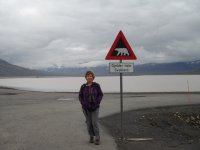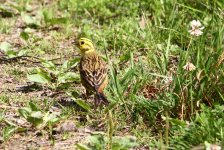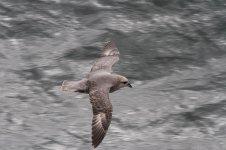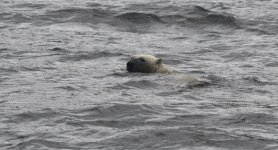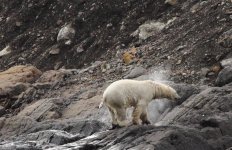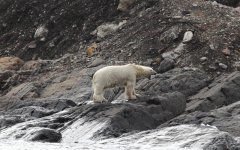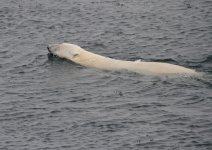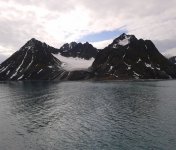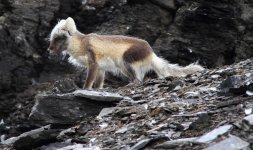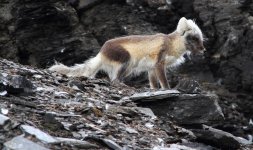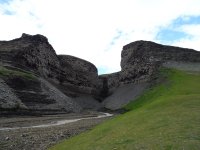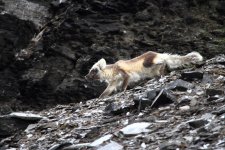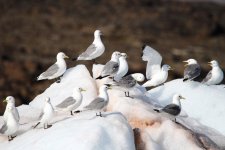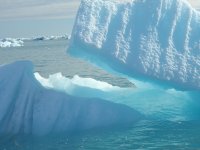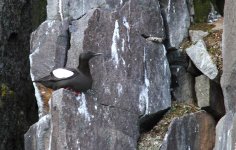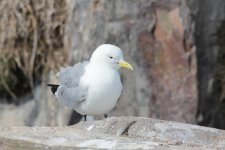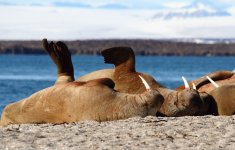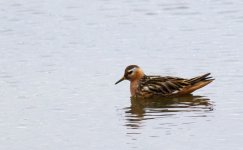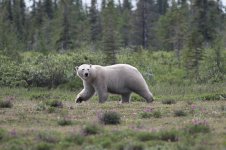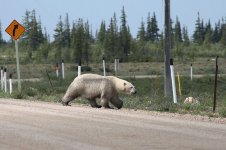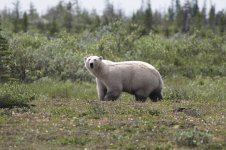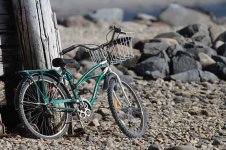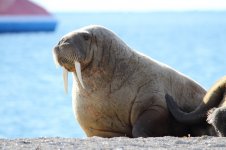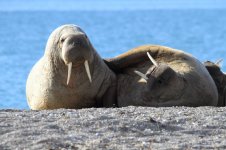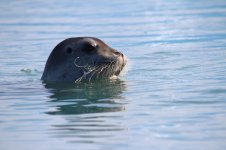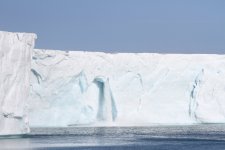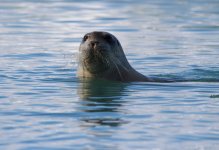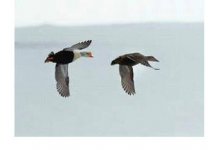We had wanted to see polar bears for many years but were torn between trying to see them in the wild of the Arctic, or just going to Churchill, Canada in October/November and almost certainly seeing them around the town while waiting for the pack ice to form.
I had always favoured seeing them swimming, hunting and acting in a natural way but Sarah after some pretty bad sea-sickness in Antartica and around New Zealand was reluctant to spend much time at sea which would usually be required for this approach. However at last years Birdfair we attended a talk where the cruise around Svalbard was presented and Sarah saw that it didn’t really require much time in open water and rough seas as most of the sailing was close to land, so she said “let’s do it”.
However even last August the Naturetrek trip we fancied had no decent cabins left, so we looked for a trip that tried to go around the archipelago on a smallish ship, as that we thought guaranteed getting into the pack ice and therefore offered a better chance of bears at work. So it was we booked with Gadventures (booking nearly a year in advance got us a 15% discount and a cabin upgrade (4th Deck and Picture window).
Agenda was
Fly from Manchester to Oslo with SAS on 8th July – 7 hours waiting time so some birding near Oslo airport. Then continue flight late evening to Longyearbyen.
Overnight at Radisson Blue Longyearbyen then day exploring Longyearbyen area
July 9th board MS Expedition 16.30
July 9th – 19th – circumnavigate Svalbard (depending on ice and weather) in an anticlockwise direction stopping at various wildlife and scenic spots
July 19th – morning in Longyearbyen for last bit of birding, then fly back to Oslo PM
July 19th-20th Oslo (staying at Comfort Inn Borsparken), day for birding / site seeing
21st July Fly back to Manchester with SAS
Day 1 – Arrival in Oslo airport just after mid day, luggage checked through to Longyearbyen (note - not all flights do this as you have to clear customs in Oslo if the Longyearbyen flight is touching down at Tromso). We asked the information desk whether there were any parks or wildlife areas within a 30 minute bus ride of the airport, we didn’t want to go into Oslo at this point . The helpful girl was able to tell us about an area at Moreppen which was surrounded by woods and fields. We then went to the public transport stand and found out the bus number and the stand to get there. We had 20 minutes until the bus was due so we bought some provisions and headed off.
At the bus stop we had our first birds Jackdaw, House Sparrow and Feral Piegeon.
The bus ride took us past lots of airport car parks and round the other side of the airport before heading north into the country side. There was lots of forest around the area so it looked hopeful. We were just off the bus, fortunately with our bins around our necks when two birds flew up from near the bins, they were Nutcrackers – I couldn’t believe that these birds which we had never seen before and which I believe are usual secretive were so openly viewed. We enjoyed them for a bit but without access to the camera etc which was still in the camera pack didn’t manage any photos – (do any locals know if these are usually found around here – or just failed breeders / youngsters on the move?).
We then looked around the area; some fields, benches in an open area (an old football field) and then some woods with tracks into and a path alongside the road in both directions. We sat down at the benches and could see a couple of Spotted Flycatchers, a Pied Wagtail, at least 10 Fieldfares, 2 yellowhammers and a blackbird, while we had lunch. After lunch we headed down the tracks into the woods, first up were some great tit, Willow Warbler, Garden Warbler and ChiffChaff, then Mistle Thrush, Redwing and more Fieldfare, then when I was trying to photograph a YellowHammer, Sarah spotted a Woodpecker which she said had some yellow on it (I only saw distant flight views), I assume it was Three-toed but we didn’t count it as Sarah wasn’t 100% and I didn’t really see anymore than a woodpecker shape (Does anyone know if Three Toed WPs are common 30-40KM north of Oslo?).
As the afternoon wore on we managed to add a nice Rosefinch, some Blue tits, a Buzzard, Chaffinch and a lovely male Bullfinch. Flying around the field were many Swallows and Swifts and finally a Kestrel.
After 18.00 buses back to the airport went from 2 an hour to hourly, so we headed back to the airport, with plenty of time to clear security, we need not have hurried as the flight was delayed an hour. So it was after mid-night when we arrived in Longyearbyen, but the sun was still shining.
We did get two birds on the trip to the hotel, Arctic Tern and Glaucous Gull.
I had always favoured seeing them swimming, hunting and acting in a natural way but Sarah after some pretty bad sea-sickness in Antartica and around New Zealand was reluctant to spend much time at sea which would usually be required for this approach. However at last years Birdfair we attended a talk where the cruise around Svalbard was presented and Sarah saw that it didn’t really require much time in open water and rough seas as most of the sailing was close to land, so she said “let’s do it”.
However even last August the Naturetrek trip we fancied had no decent cabins left, so we looked for a trip that tried to go around the archipelago on a smallish ship, as that we thought guaranteed getting into the pack ice and therefore offered a better chance of bears at work. So it was we booked with Gadventures (booking nearly a year in advance got us a 15% discount and a cabin upgrade (4th Deck and Picture window).
Agenda was
Fly from Manchester to Oslo with SAS on 8th July – 7 hours waiting time so some birding near Oslo airport. Then continue flight late evening to Longyearbyen.
Overnight at Radisson Blue Longyearbyen then day exploring Longyearbyen area
July 9th board MS Expedition 16.30
July 9th – 19th – circumnavigate Svalbard (depending on ice and weather) in an anticlockwise direction stopping at various wildlife and scenic spots
July 19th – morning in Longyearbyen for last bit of birding, then fly back to Oslo PM
July 19th-20th Oslo (staying at Comfort Inn Borsparken), day for birding / site seeing
21st July Fly back to Manchester with SAS
Day 1 – Arrival in Oslo airport just after mid day, luggage checked through to Longyearbyen (note - not all flights do this as you have to clear customs in Oslo if the Longyearbyen flight is touching down at Tromso). We asked the information desk whether there were any parks or wildlife areas within a 30 minute bus ride of the airport, we didn’t want to go into Oslo at this point . The helpful girl was able to tell us about an area at Moreppen which was surrounded by woods and fields. We then went to the public transport stand and found out the bus number and the stand to get there. We had 20 minutes until the bus was due so we bought some provisions and headed off.
At the bus stop we had our first birds Jackdaw, House Sparrow and Feral Piegeon.
The bus ride took us past lots of airport car parks and round the other side of the airport before heading north into the country side. There was lots of forest around the area so it looked hopeful. We were just off the bus, fortunately with our bins around our necks when two birds flew up from near the bins, they were Nutcrackers – I couldn’t believe that these birds which we had never seen before and which I believe are usual secretive were so openly viewed. We enjoyed them for a bit but without access to the camera etc which was still in the camera pack didn’t manage any photos – (do any locals know if these are usually found around here – or just failed breeders / youngsters on the move?).
We then looked around the area; some fields, benches in an open area (an old football field) and then some woods with tracks into and a path alongside the road in both directions. We sat down at the benches and could see a couple of Spotted Flycatchers, a Pied Wagtail, at least 10 Fieldfares, 2 yellowhammers and a blackbird, while we had lunch. After lunch we headed down the tracks into the woods, first up were some great tit, Willow Warbler, Garden Warbler and ChiffChaff, then Mistle Thrush, Redwing and more Fieldfare, then when I was trying to photograph a YellowHammer, Sarah spotted a Woodpecker which she said had some yellow on it (I only saw distant flight views), I assume it was Three-toed but we didn’t count it as Sarah wasn’t 100% and I didn’t really see anymore than a woodpecker shape (Does anyone know if Three Toed WPs are common 30-40KM north of Oslo?).
As the afternoon wore on we managed to add a nice Rosefinch, some Blue tits, a Buzzard, Chaffinch and a lovely male Bullfinch. Flying around the field were many Swallows and Swifts and finally a Kestrel.
After 18.00 buses back to the airport went from 2 an hour to hourly, so we headed back to the airport, with plenty of time to clear security, we need not have hurried as the flight was delayed an hour. So it was after mid-night when we arrived in Longyearbyen, but the sun was still shining.
We did get two birds on the trip to the hotel, Arctic Tern and Glaucous Gull.
Last edited:





